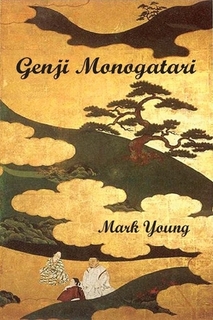
| Jacket 40 — Late 2010 | Jacket 40 Contents | Jacket Homepage | Search Jacket |
This piece is about 4 printed pages long.
It is copyright © Sheila E. Murphy and Jacket magazine 2010. See our [»»] Copyright notice.
The Internet address of this page is http://jacketmagazine.com/40/r-young-rb-murphy.shtml
Mark Young
Genji Monogatari
reviewed by
Sheila E. Murphy
Otoliths, 2010, 60 pp, isbn 978–0-9806025–8-6 , USD$14.95 (plus postage)

1
Mark Young composes Genji Monogatari according to the framework of the 11th Century classic by Marasaki Shikibu, furnishing a deeply incisive present-tense poetic piece that honors the tradition by depicting his own reading of the earlier work. From that reading emerges a tightly focused, highly philosophical rendering of intimate engagement with concrete elements within his field of attention. Each of the openings Young reveals affords the reader an opportunity to experience with the poet a miracle of economy amid directly stated poetic segments. The initial passage of the piece, “The Paulownia Court,” establishes an image of enclosure, via mention of “dolls / of various kinds.” Young references “The caption & / its reliability,” mentioning also “Struggle & combat / occur again & again.” The final line in this short, opening section, reminds us that “The function / of poetry is painfully reached.”
2
Young further shows that appearances, alongside the set stage, the elements, and configurations, remain deceptive. Relationships among the would-be separate components of perception and experience are found within the act of observation, functioning also as their creation. Amid the poet’s choice of location, objects, relations, and philosophical observations, range and specificity emerge. Throughout the book, Young acknowledges and addresses the principle of enclosure, suggesting that levels of “within-ness” remain infinite, and that the outer layers of experience may be inherently deeper than most of us have been taught to think.
3
The character of noun with which to engage retains the factor of surprise throughout this sharply, resonantly crafted volume. In “The Broom Tree,” the second section of the poetic sequence, Young acknowledges the work involved in the devotion to poetic discovery, and the uncertainty of its yield:
4
Sometimes he guessed
correctly, sometimes
not, but he preferred
to do such things him-
self rather than call in
the others who were
paid to do the tasks.
5
Authenticity embodies the pursuit, and the very title of the section reminds of removing layers, in the interest of discovering what is real. The ironic final lines, “He spent / little time with his bride” suggests the isolation of the poetic pursuit, the aforementioned “pain” of striving to find those “signal bits” that lead to patterned arrangements, located through observation while relaxing the mind to allow its own enlargement.
6
Young addresses chronology, in honor of the early text that forms the structure for his vivid sequence, continually calling to the fore lines of the face, in which “the domains / of experience & belief / intersect…” He recognizes a vast array of objects, fetishes, beings, the nearly inevitable occasion of bricolage. Among the most alluring depictions of facility in Genji Monogatari is Young’s ease in layering meaningfully the tissues of tradition as they remain actively present to the contemporary mind.
7
Forty-seven
epiphytes, grown up
in vitro, take turns
to soliloquize on how
they’ll seek revenge
for the death of a host
they never knew.
8
Young posits that the relay race in which beings participate is a function of an unconscious fact of environmental and spiritual reality. Still, a disjointedness, unpredictable yet satisfying, emerges:
9
‘I must be abstemious,’ said Genji.
‘Old men have a way of
saying things they regret
when they drink too much.’
10
Present realities are tested now and in perpetuity. Young rests with the ephemeral nature of the now. Every specific instance, when examined and absorbed, can be rendered evanescent of a broader or a more specific truth. And each instance occurs (is seen) in time. And time is artificial. Is artifice.
11
An emotional resistance to
the darkness meant she
could not paraphrase the
thoughts that accompanied
her vision loss; but something
as simple as buying panty liners
eliminated some superfluous
parts of the scientific theories
12
In Mark Young’s poetry, no moment is robbed of its richness, and when claimed within the language of appreciation, gains context, allowing a clear recognition of how “the parts” belong and clarify together. Young’s humor further enriches the lively art of taking in the various realities. “She was in a hurry to / be inspired.” He pushes the condition to its logical and illogical arrivals in the sequence he absorbs, and in the process reveals that his own pursuits are not immune to his at once critical and accepting eye. In the final section of the piece, “The Floating Bridge of Dreams,” Young concludes his sequence with references to the multiple browser windows open at the same time:
13
one of one hundred &
forty-eight You Tube
clips of The Rolling Stones
doing Sympathy for the
Devil. Most of them
are about the fishing
lure whose etymology
is entomology. I type in
‘Murasaki’ & spend the
remainder of the near
nine minutes replaying
our cached millennium.
14
What writer would not admire this perfect conclusion of a book that exemplifies trans-historic poetic making, depicting the often invisible miracle of renewal within the given time-space system of boundaries? In this exquisite sequence of poems, Mark Young crafts with a firm eye-mind coordination, an evocation of what is true and vivid beneath apparent plainsong that lives and spawns a wealth of vibrato that reveals beyond itself.

Sheila E. Murphy
Sheila E. Murphy’s most recent work is part of Dan Waber’s chapbookpress.com series, titled “this is visual poetry,” with seventeen images representing hand drawings treated by Murphy with computer graphics. Murphy’s Collected Chapbooks was released from Blue Lion Books recently. Otoliths has published her book-length collaboration with Scott Glassman, titled Quaternity. Murphy lives in Phoenix, Arizona, and has family in Sydney, a cherished location in her life.